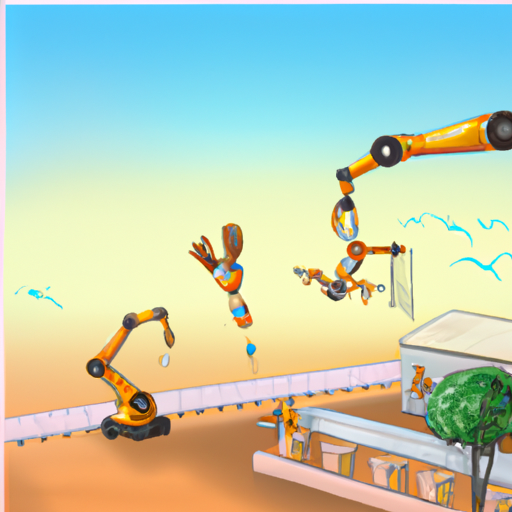-
Table of Contents
- Introduction
- Exploring the Benefits of Robotics in Manufacturing: How Automation is Transforming the Industry
- Robotics in Healthcare: How Automation is Improving Patient Care
- Robotics in Agriculture: How Automation is Revolutionizing Farming
- The Impact of Robotics on Logistics: How Automation is Streamlining Delivery Services
- Conclusion
“Robotics: Revolutionizing Industries, Enhancing Lives.”
Introduction
Robotics technology has revolutionized the way many industries operate. From manufacturing to healthcare to agriculture, robotics applications are being used to increase efficiency, reduce costs, and improve safety. Robotics can be used to automate tedious and dangerous tasks, allowing humans to focus on more complex and creative tasks. Robotics can also be used to increase accuracy and precision in a variety of industries, from manufacturing to healthcare to agriculture. In this article, we will explore the various ways robotics are being used in different industries and the potential benefits they can bring.
Exploring the Benefits of Robotics in Manufacturing: How Automation is Transforming the Industry
The manufacturing industry is undergoing a major transformation due to the introduction of robotics and automation. Automation is revolutionizing the way products are made, allowing for increased efficiency, improved safety, and cost savings. This article will explore the benefits of robotics in manufacturing and how automation is transforming the industry.
Robotics and automation are being used to increase efficiency in the manufacturing process. Automated machines can work faster and more accurately than humans, allowing for increased production speeds and improved quality control. Automation also reduces the need for manual labor, which can help to reduce costs and improve safety. Automated machines can also be programmed to perform complex tasks, such as welding and assembly, which can reduce the need for skilled labor.
Robotics and automation are also being used to improve safety in the manufacturing process. Automated machines can be programmed to detect potential hazards and take corrective action before an accident occurs. Automated machines can also be programmed to follow safety protocols, such as wearing protective gear and following safety procedures. This can help to reduce the risk of injury or death in the workplace.
Robotics and automation are also being used to reduce costs in the manufacturing process. Automated machines can be programmed to perform tasks more quickly and accurately than humans, which can reduce the need for manual labor and help to reduce costs. Automated machines can also be programmed to perform complex tasks, such as welding and assembly, which can reduce the need for skilled labor.
Robotics and automation are transforming the manufacturing industry by increasing efficiency, improving safety, and reducing costs. Automated machines can be programmed to perform complex tasks, such as welding and assembly, which can reduce the need for skilled labor. Automated machines can also be programmed to detect potential hazards and take corrective action before an accident occurs. This can help to reduce the risk of injury or death in the workplace. Automated machines can also be programmed to follow safety protocols, such as wearing protective gear and following safety procedures.
In conclusion, robotics and automation are revolutionizing the manufacturing industry by increasing efficiency, improving safety, and reducing costs. Automated machines can be programmed to perform complex tasks, detect potential hazards, and follow safety protocols. This can help to reduce the risk of injury or death in the workplace and improve the overall efficiency of the manufacturing process.
Robotics in Healthcare: How Automation is Improving Patient Care
Robotics in healthcare is revolutionizing the way medical professionals provide patient care. Automation is improving patient care by increasing accuracy, reducing costs, and improving efficiency.
Robots are being used to perform a variety of tasks in healthcare, from surgery to diagnostics. In surgery, robots are used to perform minimally invasive procedures with greater precision than a human surgeon. This reduces the risk of complications and improves patient outcomes. In diagnostics, robots are being used to analyze medical images and detect abnormalities with greater accuracy than a human radiologist. This helps to reduce misdiagnoses and improve patient care.
Robots are also being used to automate mundane tasks, such as dispensing medication and transporting medical supplies. This reduces the amount of time medical professionals need to spend on these tasks, freeing them up to focus on providing patient care. Automation also reduces the risk of human error, which can lead to medical mistakes and adverse events.
Robots are also being used to improve the efficiency of healthcare delivery. Automation can help streamline processes, such as scheduling appointments and ordering tests. This reduces wait times and improves patient satisfaction. Automation can also help reduce costs by eliminating the need for manual labor and reducing the amount of time needed to complete tasks.
Robotics in healthcare is revolutionizing the way medical professionals provide patient care. Automation is improving patient care by increasing accuracy, reducing costs, and improving efficiency. As technology continues to advance, robots will become even more integrated into healthcare, leading to even greater improvements in patient care.
Robotics in Agriculture: How Automation is Revolutionizing Farming
Robotics in agriculture is revolutionizing the way farmers grow and harvest crops. Automation is allowing farmers to increase their yields, reduce labor costs, and improve the quality of their produce. This technology is transforming the way farmers manage their land and is helping to ensure a more sustainable future for the agricultural industry.
Robotics in agriculture is being used to automate many of the labor-intensive tasks associated with farming. Automated tractors and harvesters are being used to plow, plant, and harvest crops. These machines are able to work faster and more efficiently than human labor, allowing farmers to increase their yields and reduce labor costs. Automated systems are also being used to monitor crop health and soil conditions, allowing farmers to make more informed decisions about when and how to fertilize and irrigate their crops.
Robotics in agriculture is also helping to improve the quality of produce. Automated systems are being used to monitor the ripeness of fruits and vegetables, ensuring that only the best produce is harvested. Automated systems are also being used to detect pests and diseases, allowing farmers to take action before the problem becomes too severe.
Robotics in agriculture is helping to ensure a more sustainable future for the agricultural industry. Automated systems are reducing the amount of water and fertilizer needed to grow crops, reducing the environmental impact of farming. Automated systems are also helping to reduce the amount of labor needed to manage farms, allowing farmers to focus on other aspects of their business.
Robotics in agriculture is revolutionizing the way farmers grow and harvest crops. Automation is allowing farmers to increase their yields, reduce labor costs, and improve the quality of their produce. This technology is transforming the way farmers manage their land and is helping to ensure a more sustainable future for the agricultural industry.
The Impact of Robotics on Logistics: How Automation is Streamlining Delivery Services
The rise of robotics and automation has had a profound impact on the logistics industry, revolutionizing the way goods are delivered and received. Automation has enabled companies to streamline their delivery services, providing customers with faster, more efficient, and more cost-effective solutions.
Robotics has enabled companies to automate many of the processes involved in the delivery of goods. Automated sorting systems can quickly and accurately sort packages according to size, weight, and destination. Automated conveyor belts can move packages quickly and efficiently from one point to another. Automated loading and unloading systems can quickly and accurately load and unload packages from trucks and other vehicles. Automated delivery vehicles can navigate roads and streets with minimal human intervention, allowing for faster and more efficient delivery.
Robotics has also enabled companies to reduce labor costs associated with delivery services. Automated sorting, loading, and unloading systems require minimal human intervention, allowing companies to reduce the number of employees needed to manage these processes. Automated delivery vehicles can also reduce the need for human drivers, allowing companies to reduce labor costs associated with delivery services.
Robotics has also enabled companies to improve the accuracy and reliability of their delivery services. Automated sorting systems can quickly and accurately sort packages according to size, weight, and destination. Automated delivery vehicles can navigate roads and streets with minimal human intervention, allowing for faster and more reliable delivery. Automated loading and unloading systems can quickly and accurately load and unload packages from trucks and other vehicles.
The rise of robotics and automation has had a profound impact on the logistics industry, revolutionizing the way goods are delivered and received. Automation has enabled companies to streamline their delivery services, providing customers with faster, more efficient, and more cost-effective solutions. By reducing labor costs, improving accuracy and reliability, and automating many of the processes involved in the delivery of goods, robotics has enabled companies to provide customers with a superior delivery experience.
Conclusion
Robotics applications have the potential to revolutionize the way various industries operate. From manufacturing to healthcare to agriculture, robotics can help automate processes, reduce costs, and improve efficiency. As technology continues to advance, robotics applications will become increasingly prevalent in all industries, allowing for greater productivity and improved customer service. With the right investments and strategies, robotics can help create a more efficient and profitable future for all industries.




